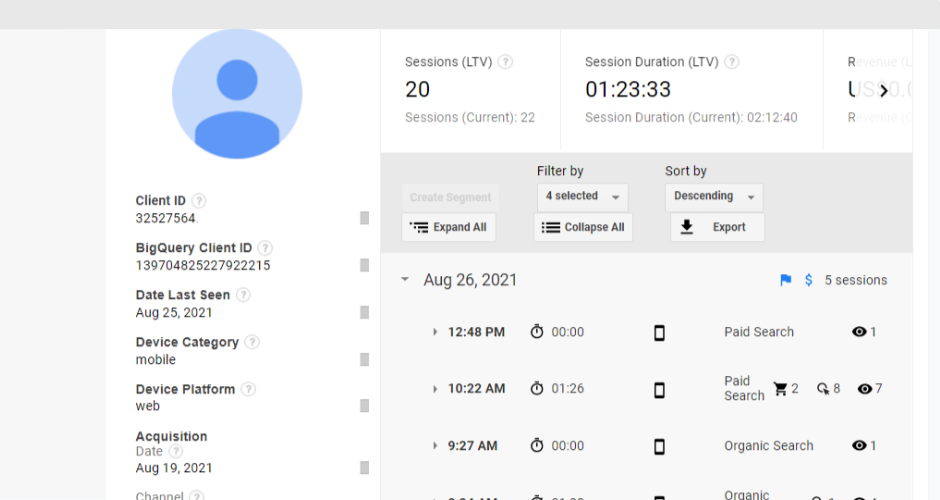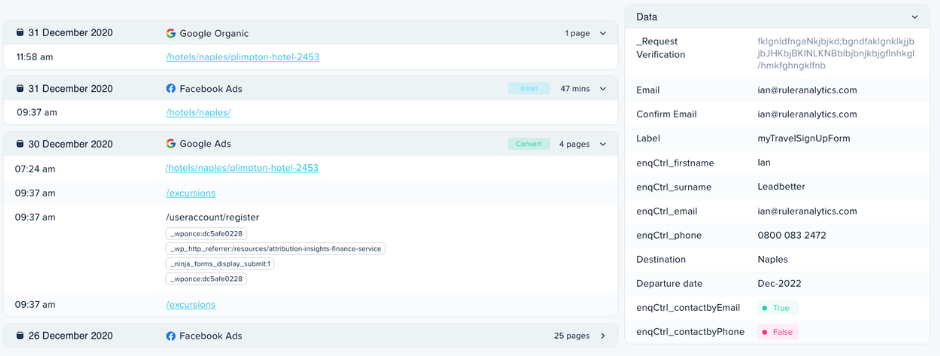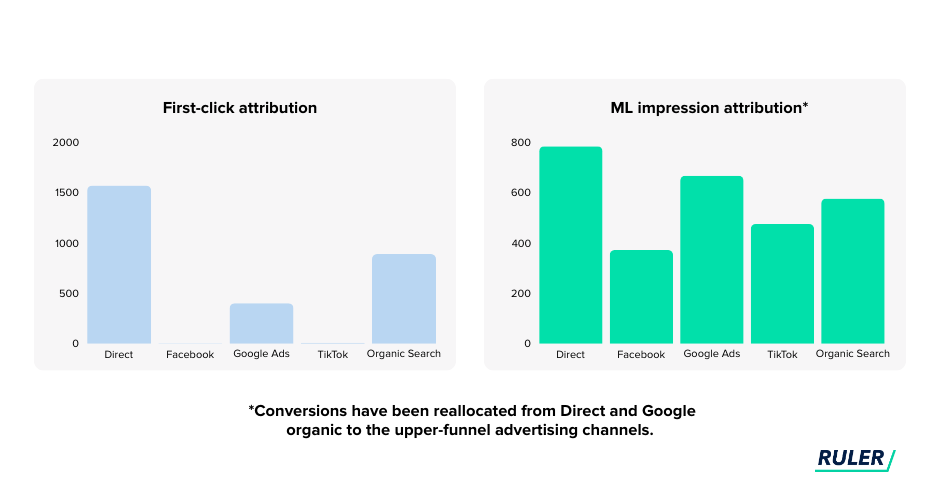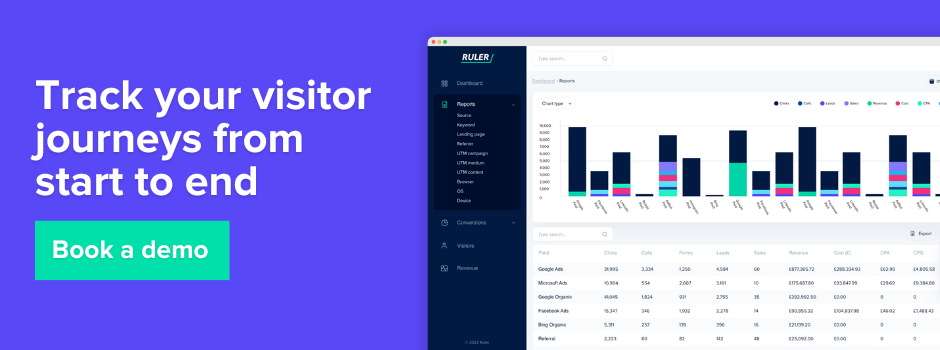Let’s talk about sessions and what role they play in Google Analytics 4.
Google Analytics is the most used digital analytics service. Our data backs it up. 90% of marketers consider Google Analytics their go-to choice for marketing measurement.
We can’t say we’re surprised. Google Analytics is free and provides over 200 predefined metrics to evaluate the impact of your website and marketing.
One notable metric used across Google Analytics 4 is sessions.
But what are sessions, and how important are they to your marketing?
Let’s find out together in this easy-to-follow guide.
Keep reading to learn:
💡 Pro Tip
Ruler makes the process of tracking your website users much easier. It tracks data on a visitor level, allowing you to successfully attribute leads and marketing-generated revenue across multiple campaigns, ads, keywords and more. Plus, unlike GA4, Ruler uses impression modelling to acknowledge the impact of your upper-funnel, impression heavy channels like Meta, TikTok and LinkedIn.
Book a demo to see how Ruler does both
A session in Google Analytics 4 is defined as a group of events recorded for a user in a given time period.
A session could contain multiple events including page views, event completions or eCommerce transactions.
You can view sessions in the following reports available in Google Analytics 4:
Sessions are a popular metric among marketers because they allow you to:
GA4 is the latest version of analytics. Before that, we had Universal Analytics. The way GA4 counts sessions is slightly different to UA
Despite the differences in data tracking, the way Google Analytics counts sessions has stayed the same. GA4 uses first-party cookies to record data and sessions on your website.
First-party cookies are used to track user behaviour. These cookies allow website owners to collect information about people who visit their website.
Related: All you need to know about first-party and third-party cookies
Let’s say a user first arrives on your site by clicking on a LinkedIn ad. They take a look around your website and leave.
Later that day, they type your company name into Google using the same device, click a branded search ad, and fill out a form.
Using cookie data and the User ID, Analytics can determine that these visits are from the same user. They’ll register them as separate sessions, but Google Analytics will know that both sessions came from the same device.
Without cookie data, Google Analytics wouldn’t be able to attribute multiple interactions to the same user. Instead, it would consider every page view a new unique visitor.
While sessions and users appear similar, they’re actually quite different.
We know a session in GA4 is when a visitor makes a series of events on your site in a 30 minute period. This can include multiple pageviews, clicks and transactions, etc.
A user, however, is an individual person who has come to your site and initiated a session. You can treat users as the number of unique visitors coming to your website.
Once a user lands on your website, they will not be counted again. Unless, of course, they visit on another device or have cleared their cookies. In this event, Google Analytics 4 would consider them an additional user.
At this point, you’re probably wondering whether it’s better to measure users over sessions. The answer depends on your specific objectives.
Most marketers often use both sessions and users to show how effective marketing is at bringing people to the website.
Overall users provide valuable data on which pages get the most traffic and new users give you a better understanding of your reach and visibility.
Sessions, on the other hand, offer a more accurate view of how many people have clicked into a page and what they have done after they’ve entered your site.
It boils down to your preferences and whatever is most convenient for you.
💡 Pro Tip
Ruler’s Paths Report lets you see which ads, emails, and social media posts bring in the most revenue and track how long it takes people to convert and how many touchpoints they use. Read more about Ruler’s Path Report or book a demo to see it in action.
While Google Analytics does a good job at tracking your website users and sessions, it isn’t perfect.
One significant issue with Google Analytics 4 is that the data is anonymised.
GA4 has the ability to track individual users. It sets a cookie whenever a user enters your website and assigns them with a unique anonymous id.
You can click-through and see the different interactions each visitor has completed on your website such as a view, event or purchase.

Sounds useful, but there is a big flaw.
Google Analytics 4 can’t assign personal identifiable information such email addresses or phone numbers to user data.
With its inability to track personal identifiable information, the connection between sessions and revenue is effectively lost.
If you can’t see where visitors are converting into leads, you can’t attribute revenue back to your marketing and accurately measure your impact on pipeline generation.
Many marketers have realised the data in Google Analytics isn’t enough to effectively evidence marketing’s impact and have begun introducing attribution technology into their existing tech stack.
The data backs it up. By 2031, the marketing attribution software market is expected to reach USD 12.9 Billion.
And this doesn’t come as a shock.
Marketing attribution tools have revolutionised the marketing measurement of companies.
Take Ruler Analytics, for example.

Ruler has allowed marketers to isolate activity to each specific user, allowing them to track each and every digital touchpoint towards a conversion.
Related: How to view full customer journeys in Ruler
It integrates with just about any sales and marketing tool. So you can see where your highest-value leads are coming from and attribute revenue across multiple campaigns, ads, and keywords with complete confidence.
We have plenty of content on how Ruler works. You can start with our blog post on how Ruler attributes revenue back to your marketing.
Simply put, data sampling is a statistical analysis technique used to examine and interpret a subset of your traffic.
This is how Google explains it:
“For example, if you wanted to estimate the number of trees in a 100-acre area where the distribution of trees was fairly uniform, you could count the number of trees in 1 acre and multiply by 100.”
Data sampling only comes into play if you cross the threshold of 500,000 sessions in any given time period. If your website attracts a small number of visitors a day, the likelihood of you falling into the trap of data sampling is small.
If you do draw in thousands of users to your website, chances are you’re missing out on data about your visitors and their sessions.
GA4 tends to lean towards click-heavy channels when attributing conversions.
One reason for this is that people often view ads on platforms like Meta, TikTok, or YouTube, but they don’t click right away.
Instead, they come back later through organic search or direct.
Because of this, you’ll likely have higher session counts and more conversions attributed to those “last-click” channels, even though the impression-based platforms played a major role in the customer journey.
This makes impression-heavy platforms look less effective and more expensive than they really are.
In a lot cases, marketers end up shifting budget away from channels that are actually driving growth in the long run, leading to stagnant or even declining performance.
To combat this, we’ve introduced impression modelling alongside our click-based attribution tracking.
By using Bayesian statistics, we’ve developed algorithms that can connect ad impressions to later conversions, even when there’s no direct click.

Once these impressions are matched, we apply Shapley Regression to fairly distribute credit across all touchpoints, not just the final click.
This allows us to redistribute conversions from organic search and direct to more deserving channels, uncovering the true contribution of those that don’t directly lead to clicks, like social media or display advertising.
You can dive into our guide on impression modelling for all the details on how it works.
Sessions in Google Analytics is a metric used by many marketing teams to understand whether or not their campaigns are working to drive traffic and conversions.
And rightly so.
GA4 sessions are easy to track and follow. In our opinion, sessions are a metric you should have your eye on. It’s handy to know where visitors are landing on your website.
While sessions give you some insight into your users journey, they don’t fully capture all of the micro-interactions on your website. To do this, your best bet is to look into web visitor tracking.
Ruler, for example, tracks your users through their full customer journey. It can tell you where a closed deal has come from and attributes the revenue back to the touchpoints that ultimately led to the conversion.
Plus, as an added bonus, it uses impression modelling to ensure your upper-funnel campaigns get the recognition they deserve.
By booking a demo, you can see exactly how it works and the benefits it holds.
